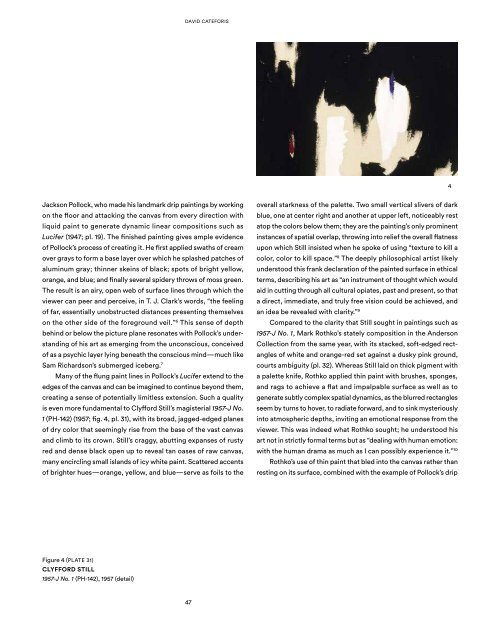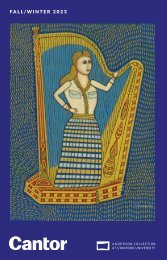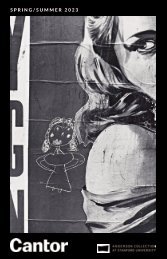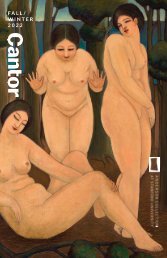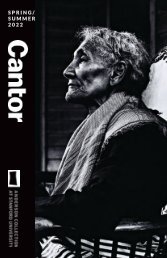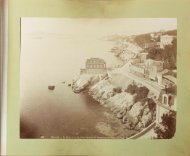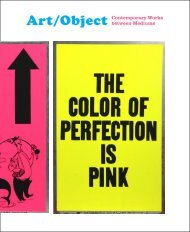A Family Affair
Essays on Modern and Contemporary Art from the Anderson Collection at Stanford University
Essays on Modern and Contemporary Art from the Anderson Collection at Stanford University
You also want an ePaper? Increase the reach of your titles
YUMPU automatically turns print PDFs into web optimized ePapers that Google loves.
DAVID CATEFORIS<br />
4<br />
Jackson Pollock, who made his landmark drip paintings by working<br />
on the floor and attacking the canvas from every direction with<br />
liquid paint to generate dynamic linear compositions such as<br />
Lucifer (1947; pl. 19). The finished painting gives ample evidence<br />
of Pollock’s process of creating it. He first applied swaths of cream<br />
over grays to form a base layer over which he splashed patches of<br />
aluminum gray; thinner skeins of black; spots of bright yellow,<br />
orange, and blue; and finally several spidery throws of moss green.<br />
The result is an airy, open web of surface lines through which the<br />
viewer can peer and perceive, in T. J. Clark’s words, “the feeling<br />
of far, essentially unobstructed distances presenting themselves<br />
on the other side of the foreground veil.” 6 This sense of depth<br />
behind or below the picture plane resonates with Pollock’s understanding<br />
of his art as emerging from the unconscious, conceived<br />
of as a psychic layer lying beneath the conscious mind—much like<br />
Sam Richardson’s submerged iceberg. 7<br />
Many of the flung paint lines in Pollock’s Lucifer extend to the<br />
edges of the canvas and can be imagined to continue beyond them,<br />
creating a sense of potentially limitless extension. Such a quality<br />
is even more fundamental to Clyfford Still’s magisterial 1957-J No.<br />
1 (PH-142) (1957; fig. 4, pl. 31), with its broad, jagged-edged planes<br />
of dry color that seemingly rise from the base of the vast canvas<br />
and climb to its crown. Still’s craggy, abutting expanses of rusty<br />
red and dense black open up to reveal tan oases of raw canvas,<br />
many encircling small islands of icy white paint. Scattered accents<br />
of brighter hues—orange, yellow, and blue—serve as foils to the<br />
overall starkness of the palette. Two small vertical slivers of dark<br />
blue, one at center right and another at upper left, noticeably rest<br />
atop the colors below them; they are the painting’s only prominent<br />
instances of spatial overlap, throwing into relief the overall flatness<br />
upon which Still insisted when he spoke of using “texture to kill a<br />
color, color to kill space.” 8 The deeply philosophical artist likely<br />
understood this frank declaration of the painted surface in ethical<br />
terms, describing his art as “an instrument of thought which would<br />
aid in cutting through all cultural opiates, past and present, so that<br />
a direct, immediate, and truly free vision could be achieved, and<br />
an idea be revealed with clarity.” 9<br />
Compared to the clarity that Still sought in paintings such as<br />
1957-J No. 1, Mark Rothko’s stately composition in the Anderson<br />
Collection from the same year, with its stacked, soft-edged rectangles<br />
of white and orange-red set against a dusky pink ground,<br />
courts ambiguity (pl. 32). Whereas Still laid on thick pigment with<br />
a palette knife, Rothko applied thin paint with brushes, sponges,<br />
and rags to achieve a flat and impalpable surface as well as to<br />
generate subtly complex spatial dynamics, as the blurred rectangles<br />
seem by turns to hover, to radiate forward, and to sink mysteriously<br />
into atmospheric depths, inviting an emotional response from the<br />
viewer. This was indeed what Rothko sought; he understood his<br />
art not in strictly formal terms but as “dealing with human emotion:<br />
with the human drama as much as I can possibly experience it.” 10<br />
Rothko’s use of thin paint that bled into the canvas rather than<br />
resting on its surface, combined with the example of Pollock’s drip<br />
Figure 4 (PLATE 31)<br />
CLYFFORD STILL<br />
1957-J No. 1 (PH-142), 1957 (detail)<br />
47


